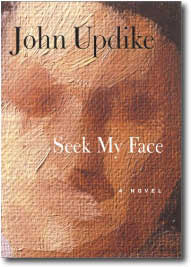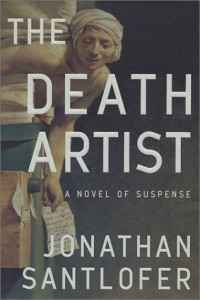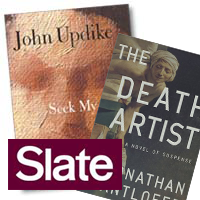by Carol Kino
There’s a terrific art world novel out this season, and it isn’t Updike’s.
 American art novels tend to come in two varieties—commercial and literary. The commercial kind tends to focus on chic-but-sleazy openings and socializing, which are undoubtedly the most vapid, least interesting aspect of the scene. The literary kind usually gives this cliché-ridden territory a twist by interpolating the life story of another cliché—some saintly personage who seeks bliss far from the madding crowd, in plain old traditional painting. It goes without saying that both kinds are usually penned by people who seem to have little insight into the world they attempt to conjure.
American art novels tend to come in two varieties—commercial and literary. The commercial kind tends to focus on chic-but-sleazy openings and socializing, which are undoubtedly the most vapid, least interesting aspect of the scene. The literary kind usually gives this cliché-ridden territory a twist by interpolating the life story of another cliché—some saintly personage who seeks bliss far from the madding crowd, in plain old traditional painting. It goes without saying that both kinds are usually penned by people who seem to have little insight into the world they attempt to conjure.
John Updike’s Seek My Face, this fall’s leading entry into the art novel sweepstakes, falls straightinto the same traps as so many other literary art novels. It’s a roman à clef that uses a semi-invented artist character to re-imagine the story of postwar American art. Happily, though, the season also offers a worthy competitor: Jonathan Santlofer’s The Death Artist, a whodunitthat focuses on the hunt for a serial killer who uses his victim’s corpses to restage great artworks. Santlofer’s potboiler genre may be clichéd, yet his story is anything but.
 Seek My Face depicts a day in the life of Hope Chafetz, an elderly painter-recluse, now living in Vermont, who has agreed to spend her day being interviewed by Kathryn, a 27-year-old New York art critic. Using Hope’s answers and interior flashbacks, Updike sketches out what amounts to a thinly veiled personal history of the Abstract Expressionist group. Hermann Hochmann, Hope’s painting teacher, must be the Ab Ex precursor Hans Hofmann; Bernie Nova is Barnett Newman; and Hope herself is clearly a variation on Lee Krasner, Jackson Pollock’s unfortunate wife.
Seek My Face depicts a day in the life of Hope Chafetz, an elderly painter-recluse, now living in Vermont, who has agreed to spend her day being interviewed by Kathryn, a 27-year-old New York art critic. Using Hope’s answers and interior flashbacks, Updike sketches out what amounts to a thinly veiled personal history of the Abstract Expressionist group. Hermann Hochmann, Hope’s painting teacher, must be the Ab Ex precursor Hans Hofmann; Bernie Nova is Barnett Newman; and Hope herself is clearly a variation on Lee Krasner, Jackson Pollock’s unfortunate wife.
In practice, though, Hope is more of an art historical Forrest Gump, for in her youth—conveniently and improbably enough—she bedded many of America’s major postwar talents and even married two. Husband No. 1 is Zack McCoy, a dead ringer for Pollock. Husband No. 2 is Guy Holloway, an invented character whose oeuvre is an utterly unlikely pastiche of every major totem of ’60s Pop, including Rauschenberg’s combine paintings, Oldenberg’s soft sculptures, and Warhol’s Jackie Kennedy portraits. These days, though, Hope lives alone, mulling over her past while turning out subtly wrought abstract paintings.
Though Updike’s female characters often ring somewhat false, this time they have major credibility problems. To start with, it’s tough to imagine an eighty-something female artist opening up to a young interlocutor who’s only interested in the great men in her life. Female artists of Hope’s generation have only recently begun to receive their due. Her own posterity, and her own work, would no doubt be uppermost in her mind. Yet she’s inexplicably verbose about the “two men of genius” she married and what they were like in bed (or in one case, on the studio sofa). “Did I talk about [Zack’s] beautiful body,” she says, “the way his naked chest smelled nutty? We’ve left out the way he talked, so fantastically rude and yet timidly polite at the same time.”
Similarly, it’s hard to buy the idea that any 27-year-old art critic, female or not, could be obsessed with writing a new Abstract Expressionist history—in a single article, yet—as if everything there was to say on that subject hadn’t already been said to death by the professors of the professors of her professors. These days, any young critic worth her salt is probably trying to get onto the international art exhibition gravy train by writing essays full of globalist jargon that perversely decry big international exhibitions. It’s also impossible to imagine what kind of critical piece Kathryn could have in mind, since most of her questions focus on Hope’s long-ago sexual activities.
But what really makes the whole thing seem totally off is Hope’s prolixity. Artists tend to be tuned in to the physical aspects of how things work—rather like joiners, chemists, or engineers—and painters in particular seem far more likely to process life experience in terms of form and color, rather than streams of densely literary verbiage. Similarly, Hope’s attitude toward contemporary American art—i.e., mystified and dismissive—seems like that of a writer or Sunday painter, rather than someone who was around when it all began. She blithely slags off performance art and Minimalism—even though she herself is apparently a Minimalist painter—and she can’t remember the name of the guy who parodied Husband No. 1 by making drip paintings by urinating against metallic paint. (It was Andy Warhol.)
While Updike’s Hope seems vague about her own creative world, Santlofer’s killer targets his with the accuracy of a Zen master. For his first great work, he transforms a performance artist into a cubist Picasso self-portrait. For his second, he uses a museum trustee to re-create Jacques-Louis David’s Death of Marat. For his third, he employs a pathetically past-his-prime painter to gruesomely restage Titian’s The Flaying of Marsyas.
These crimes pique the interest of the New York tabloids, which dub him the Death Artist. But all he really wants is to get the attention of best-selling art writer and socialite Kate McKinnon, who, before she got her art history Ph.D., was a homicide detective in Queens. (A clue to his fifth murder lies in the title of her doctoral thesis, “Abstract Expressionism—Painting With the Body.”)
Santlofer, a mid-career painter himself, has his territory down cold. After Kate returns to the NYPD to help solve this crime, she persuades her suspects to ante up information by dangling just the right bait. With curators, she says she’ll recommend them for a vacant museum directorship; with an artist, she hints that she’s eager to visit his studio. When she needs to prod the Death Artist into revealing his hand, she holds a press conference at which she announces that, so far, his work just isn’t good enough.
But the best moment comes when she tells the FBI’s criminal psychologist that he’s got the wrong take on this serial killer. “Rather than profile him as an ordinary psychotic, how about looking at him as an artistic personality?” she suggests, before explaining that artists are “vain, but insecure. They want attention, like you said, but hide behind their work. They like to be alone, but want their work in the public eye. Artists are all about the work.” (Updike’s Kathryn character should take note.)
Though this story may seem far-fetched, it actually grapples with brute reality. Its characters acknowledge that few Americans these days could care less about art—which is why Kate’s fellow detectives are ill-equipped to deal with this crime, and why she herself must occasionally give them deft thumbnail descriptions of subjects like Post-Minimalism and conceptualism. (Impressively, she even persuades one to take a mild interest.)
Similarly, the Death Artist himself commands the public’s attention by using the only artistic language it currently understands—sensationalism. At times, he compares himself to the British conceptual artist Damien Hirst, who originally won fame by preserving cut-up animals in vitrines and is now a regular staple of both British tabloids and international art magazines. It’s easy to envision critics making the same justifications for the Death Artist’s oeuvre as they initially did for Hirst’s—i.e., by citing historical precedents like 17th-century Dutch vanitas painting (still lifes, often featuring human skulls, that symbolize the transitory nature of life and its attendant vanities). In fact, I found myself wondering if the book’s many murders might best be classified as Actionism, body art, performance, or simply installations made from organic materials.
What works best about this book, however, is that it is something of a conceptual artwork in itself. In writing it, Santlofer (like Kate) rather subversively presents art and the art world in terms that a wide public can understand—the lingo of the thriller. The novel also has some of the same hallmarks that make a really good conceptual artwork tick: an intellectualconundrum posedwith visceral immediacy. So, while Updike’s novel tells rather than shows, Santlofer’s novel neatly sidesteps this predicament: It simply shows by being.

